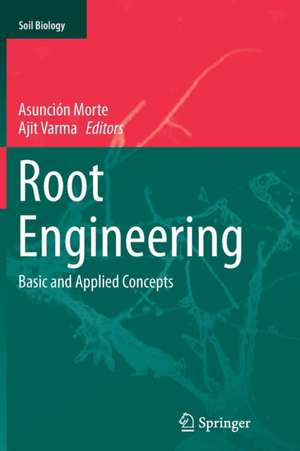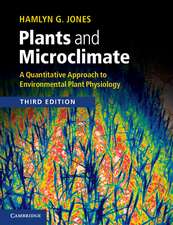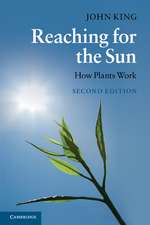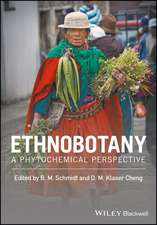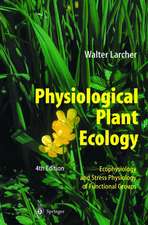Root Engineering: Basic and Applied Concepts: Soil Biology, cartea 40
Editat de Asunción Morte, Ajit Varmaen Limba Engleză Paperback – 23 aug 2016
Following initial chapters describing the anatomy and architecture as well as the growth and development of root systems, subsequent chapters focus on the various types of root symbiosis with bacteria and fungi in the rhizosphere. A third section covers the physiological strategies of roots, such as nitrate assimilation, aquaporins, the role of roots in plant defense responses and in response to droughts and salinity changes. The book’s final chapters discuss the prospects of applied engineering of roots, i.e., inventing new root structures or functions through genetic modification, but also with conventional breeding and manipulation of root symbionts. The budding field of root engineering is expected to promote a second green revolution.
| Toate formatele și edițiile | Preț | Express |
|---|---|---|
| Paperback (1) | 1390.11 lei 43-57 zile | |
| Springer Berlin, Heidelberg – 23 aug 2016 | 1390.11 lei 43-57 zile | |
| Hardback (1) | 1394.84 lei 43-57 zile | |
| Springer Berlin, Heidelberg – 29 apr 2014 | 1394.84 lei 43-57 zile |
Din seria Soil Biology
- 18%
 Preț: 958.56 lei
Preț: 958.56 lei - 18%
 Preț: 1225.62 lei
Preț: 1225.62 lei - 18%
 Preț: 957.75 lei
Preț: 957.75 lei - 18%
 Preț: 1232.09 lei
Preț: 1232.09 lei - 18%
 Preț: 949.90 lei
Preț: 949.90 lei - 18%
 Preț: 1392.95 lei
Preț: 1392.95 lei - 18%
 Preț: 952.26 lei
Preț: 952.26 lei - 18%
 Preț: 1231.32 lei
Preț: 1231.32 lei - 18%
 Preț: 956.03 lei
Preț: 956.03 lei - 18%
 Preț: 948.29 lei
Preț: 948.29 lei - 18%
 Preț: 1224.18 lei
Preț: 1224.18 lei - 18%
 Preț: 1226.90 lei
Preț: 1226.90 lei - 18%
 Preț: 952.26 lei
Preț: 952.26 lei - 18%
 Preț: 942.63 lei
Preț: 942.63 lei - 18%
 Preț: 946.55 lei
Preț: 946.55 lei - 18%
 Preț: 1221.20 lei
Preț: 1221.20 lei - 18%
 Preț: 1225.94 lei
Preț: 1225.94 lei - 18%
 Preț: 946.24 lei
Preț: 946.24 lei - 24%
 Preț: 1051.27 lei
Preț: 1051.27 lei - 18%
 Preț: 1221.02 lei
Preț: 1221.02 lei - 18%
 Preț: 947.98 lei
Preț: 947.98 lei - 18%
 Preț: 948.47 lei
Preț: 948.47 lei - 18%
 Preț: 1222.31 lei
Preț: 1222.31 lei - 18%
 Preț: 1231.64 lei
Preț: 1231.64 lei - 18%
 Preț: 1225.31 lei
Preț: 1225.31 lei - 18%
 Preț: 1229.73 lei
Preț: 1229.73 lei
Preț: 1390.11 lei
Preț vechi: 1695.25 lei
-18% Nou
Puncte Express: 2085
Preț estimativ în valută:
266.00€ • 278.43$ • 221.39£
266.00€ • 278.43$ • 221.39£
Carte tipărită la comandă
Livrare economică 31 martie-14 aprilie
Preluare comenzi: 021 569.72.76
Specificații
ISBN-13: 9783662523261
ISBN-10: 3662523264
Pagini: 504
Ilustrații: XI, 493 p. 85 illus., 42 illus. in color.
Dimensiuni: 155 x 235 x 26 mm
Greutate: 0.7 kg
Ediția:Softcover reprint of the original 1st ed. 2014
Editura: Springer Berlin, Heidelberg
Colecția Springer
Seria Soil Biology
Locul publicării:Berlin, Heidelberg, Germany
ISBN-10: 3662523264
Pagini: 504
Ilustrații: XI, 493 p. 85 illus., 42 illus. in color.
Dimensiuni: 155 x 235 x 26 mm
Greutate: 0.7 kg
Ediția:Softcover reprint of the original 1st ed. 2014
Editura: Springer Berlin, Heidelberg
Colecția Springer
Seria Soil Biology
Locul publicării:Berlin, Heidelberg, Germany
Cuprins
Parts: Anatomical and Morphological Strategies of Roots.- Rhizosphere and Microorganisms.- Physiological Strategies of Roots.- Applied Engineering of Roots.
Recenzii
“We enjoyed reading this book and would recommend it to anyone with an interest in crop breeding, agronomy, and sustainable agriculture. Importantly, this book will serve as an introductory course in root biology for undergraduate and graduate students, and as a useful resource of anecdotes for teachers. … this book will inspire established scientists to future innovations, while youngsters will find it useful as a tool to guide novel experiments.” (P. C. Abhilash and Rama Kant Dubey, Trends in Plant Science, Vol. 20 (7), July, 2015)
“Morte (Univ. of Murcia, Spain) and Varma (Amity Univ., India) have compiled varied but mostly too-brief contributions representing many aspects of root biology. The 22-chapter book does cover both applied and fundamental issues, but for most readers, the result could be more coherent with the topics better integrated and related. Summing Up: Recommended. Upper-division undergraduates, graduate students, and researchers/faculty.” (W. Loescher, Choice, Vol. 52 (6), February, 2015)
“Morte (Univ. of Murcia, Spain) and Varma (Amity Univ., India) have compiled varied but mostly too-brief contributions representing many aspects of root biology. The 22-chapter book does cover both applied and fundamental issues, but for most readers, the result could be more coherent with the topics better integrated and related. Summing Up: Recommended. Upper-division undergraduates, graduate students, and researchers/faculty.” (W. Loescher, Choice, Vol. 52 (6), February, 2015)
Textul de pe ultima copertă
This volume illustrates the complex root system, including the various essential roles of roots as well as their interaction with diverse microorganisms localized in or near the root system.
Following initial chapters describing the anatomy and architecture as well as the growth and development of root systems, subsequent chapters focus on the various types of root symbiosis with bacteria and fungi in the rhizosphere. A third section covers the physiological strategies of roots, such as nitrate assimilation, aquaporins, the role of roots in plant defense responses, and in response to droughts and salinity changes. The book’s final chapters discuss the prospects of applied engineering of roots, i.e., inventing new root structures or functions through genetic modification, but also with conventional breeding and manipulation of root symbionts. The budding field of root engineering is expected to promote a second green revolution.
Following initial chapters describing the anatomy and architecture as well as the growth and development of root systems, subsequent chapters focus on the various types of root symbiosis with bacteria and fungi in the rhizosphere. A third section covers the physiological strategies of roots, such as nitrate assimilation, aquaporins, the role of roots in plant defense responses, and in response to droughts and salinity changes. The book’s final chapters discuss the prospects of applied engineering of roots, i.e., inventing new root structures or functions through genetic modification, but also with conventional breeding and manipulation of root symbionts. The budding field of root engineering is expected to promote a second green revolution.
Caracteristici
A valuable source of information for scientists in soil ecology, agriculture, plant sciences and microbiology Provides basic research results as well as practical applications With contributions by internationally recognized scientists Includes supplementary material: sn.pub/extras
